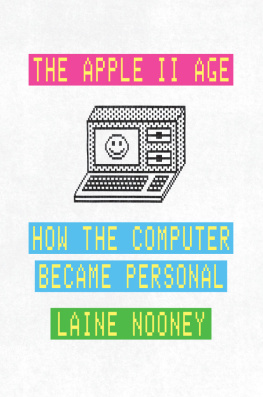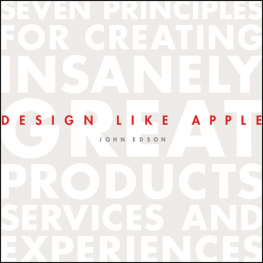The Apple Way
Jeffrey L. Cruikshank


Copyright 2006 by McGraw-Hill. All rights reserved. Except as permitted under the United States Copyright Act of 1976, no part of this publication may be reproduced or distributed in any form or by any means, or stored in a database or retrieval system, without the prior written permission of the publisher.
ISBN: 978-0-07-148315-5
MHID: 0-07-148315-2
The material in this eBook also appears in the print version of this title: ISBN: 978-0-07-226233-9, MHID: 0-07-226233-8.
All trademarks are trademarks of their respective owners. Rather than put a trademark symbol after every occurrence of a trademarked name, we use names in an editorial fashion only, and to the benefit of the trademark owner, with no intention of infringement of the trademark. Where such designations appear in this book, they have been printed with initial caps.
McGraw-Hill eBooks are available at special quantity discounts to use as premiums and sales promotions, or for use in corporate training programs. To contact a representative please e-mail us at bulksales@mcgraw-hill.com.
This publication is designed to provide accurate and authoritative information in regard to the subject matter covered. It is sold with the understanding that neither the author nor the publisher is engaged in rendering legal, accounting, or other professional service. If legal advice or other expert assistance is required, the services of a competent professional person should be sought.
From a Declaration of Principles jointly adopted by a Committee of the American Bar Association and a Committee of Publishers
TERMS OF USE
This is a copyrighted work and The McGraw-Hill Companies, Inc. (McGraw-Hill) and its licensors reserve all rights in and to the work. Use of this work is subject to these terms. Except as permitted under the Copyright Act of 1976 and the right to store and retrieve one copy of the work, you may not decompile, disassemble, reverse engineer, reproduce, modify, create derivative works based upon, transmit, distribute, disseminate, sell, publish or sublicense the work or any part of it without McGraw-Hills prior consent. You may use the work for your own noncommercial and personal use; any other use of the work is strictly prohibited. Your right to use the work may be terminated if you fail to comply with these terms.
THE WORK IS PROVIDED AS IS. McGRAW-HILL AND ITS LICENSORS MAKE NO GUARANTEES OR WARRANTIES AS TO THE ACCURACY, ADEQUACY OR COMPLETENESS OF OR RESULTS TO BE OBTAINED FROM USING THE WORK, INCLUDING ANY INFORMATION THAT CAN BE ACCESSED THROUGH THE WORK VIA HYPERLINK OR OTHERWISE, AND EXPRESSLY DISCLAIM ANY WARRANTY, EXPRESS OR IMPLIED, INCLUDING BUT NOT LIMITED TO IMPLIED WARRANTIES OF MERCHANTABILITY OR FITNESS FOR A PARTICULAR PURPOSE. McGraw-Hill and its licensors do not warrant or guarantee that the functions contained in the work will meet your requirements or that its operation will be uninterrupted or error free. Neither McGraw-Hill nor its licensors shall be liable to you or anyone else for any inaccuracy, error or omission, regardless of cause, in the work or for any damages resulting therefrom. McGraw-Hill has no responsibility for the content of any information accessed through the work. Under no circumstances shall McGraw-Hill and/or its licensors be liable for any indirect, incidental, special, punitive, consequential or similar damages that result from the use of or inability to use the work, even if any of them has been advised of the possibility of such damages. This limitation of liability shall apply to any claim or cause whatsoever whether such claim or cause arises in contract, tort or otherwise.
To Judy Kohn, who figured out Apple way before I did.
About the Author
Jeffrey L. Cruikshank was the co-founder of Kohn Cruikshank, Inc., a Boston-based consulting firm that served corporate and institutional clients for more than twelve years. In September of 2001, Kohn Cruikshank moved to Milton and became The Cruikshank Company, Inc.
Cruikshank is a graduate of Amherst College, and worked with a number of companies and schools in the Boston area in the 1970s and 1980s. In 1980, he became the editor of the Harvard Business School Bulletin, beginning a relationship with that school that has continued since then, and has led to many other engagements in the worlds of education and business.
In addition to helping shape key communications for dozens of public and private institutions, Cruikshank is the author or co-author of numerous books of interest to managers. These include histories of the Harvard Business School, New England Electric, Cummins Engine Company, The Weather Channel, and Perdue Farms. He has also written a book on corporations and architecture for Herman Miller, Inc.; the definitive guide to art in public places (Going Public); and books on numerous other subjects, ranging from logistics in the Gulf War (Moving Mountains) to entrepreneurship (Low Risk, High Reward) to the inner workings of the commercial real estate industry (The Real Estate Game). In 2005, he published his first murder mystery (Murder at the B-School).
Introduction
A Tale of Two Introductions
A foolish consistency is the hobgoblin of little minds, adored by little statesmen and philosophers and divines.
Ralph Waldo Emerson
Apple thought they had it right, this time.
The date: January 19, 1983. The place: the Flint Center at De Anza College, less than a mile down the road from Apples headquarters on Bandley Drive in Cupertino, California. The event: the formal unveiling of Apples new flagship product at the companys annual meeting.
The product was a computer, of course, and it was called the Lisa, whichdepending on who was doing the explainingeither stood for local integrated software architecture, or was the name of Apple cofounder Steve Jobss daughter, or both.
The Lisa had been in development since the fall of 1978, when Jobs began focusing on a new computer that would replace the aging Apple II. At that time, Jobs envisioned a machine that would sell for $2,000, and be aimed primarily at the business market. The new machine would be only an evolutionary step beyond what Apple was already producing. In other words, it would be another heavy, clunky, small machinesmall being only a relative termwith a built-in green-phosphor display, a more or less conventional user interface, and so on. Nevertheless, Jobs had high hopes for the new machine, which he hoped would shore
So, planning began along those lines. Then, about a year laterin November 1979fate intervened. Against his better judgment, Jobs was persuaded to visit the Xerox Palo Alto Research Center (PARC). The PARC laboratories have since achieved legendary status as a place of astonishing innovation, a place of bubbling technological ferment. But back then, it took some arm-twisting to get Jobs to stop by the sprawling, modernistic complex at 3333 Coyote Hill Road in nearby Palo Alto. By all accounts, Jobs didnt think that stodgy old Xerox had much to teach Apple Computer, which was then flying high: growing at astronomical rates, getting ready for its second private placement, and generally (pun unavoidable) the apple of Wall Streets eye.












